“Atelier” — a word that evokes images of creativity, skill, and meticulous craftsmanship. Rooted in the traditions of fine arts and haute couture, an atelier is more than just a workshop; it is a sanctuary where creativity flourishes, where ideas take shape, and where the mastery of technique meets the pursuit of artistic vision. This article explores the rich history, significance, and contemporary relevance of the atelier across various disciplines, from fashion and design to fine arts and beyond.
Origins and Evolution of the Atelier
The concept of the atelier traces its roots back to medieval Europe, where it served as a workshop for artists, craftsmen, and artisans. These workshops were essential hubs of creativity and learning, where apprentices trained under masters to hone their skills in various disciplines such as painting, sculpture, and metalwork.
During the Renaissance, the atelier evolved alongside the burgeoning interest in humanism and the arts. Prominent artists like Leonardo da Vinci and Michelangelo operated bustling ateliers where they not only created their own masterpieces but also mentored aspiring artists, passing down their techniques and knowledge through generations.
In the realm of fashion, the atelier took on a different significance. In Paris, particularly during the 19th and 20th centuries, couturiers such as Charles Frederick Worth and Coco Chanel established ateliers where they designed and created bespoke garments for wealthy clients. These ateliers became synonymous with luxury, exclusivity, and unparalleled craftsmanship, setting the standard for haute couture around the world.
The Atelier Today: Bridging Tradition and Innovation
In contemporary times, the atelier continues to thrive as a symbol of artistic excellence and craftsmanship. While the traditional atelier model still exists in sectors like haute couture fashion and bespoke tailoring, its influence has expanded to encompass a broader range of creative disciplines.
In the visual arts, modern ateliers serve as incubators for both established and emerging artists. These spaces provide artists with the resources, community, and mentorship needed to explore new techniques, experiment with different mediums, and push the boundaries of artistic expression. Ateliers specializing in disciplines such as painting, sculpture, printmaking, and digital art foster a collaborative environment where artists can exchange ideas and refine their skills under the guidance of experienced mentors.
Similarly, in the realm of design and craftsmanship, contemporary ateliers are hubs of innovation and creativity. From furniture design and jewelry making to ceramics and glassblowing, artisans and designers collaborate in ateliers to create bespoke pieces that blend traditional techniques with modern aesthetics. These ateliers not only preserve age-old craftsmanship but also adapt it to meet the demands of contemporary design trends and consumer preferences.
The Role of Technology in Modern Ateliers
While rooted in tradition, modern ateliers also embrace technological advancements to enhance creativity and efficiency. Digital tools such as computer-aided design (CAD) software, 3D printing, and laser cutting have revolutionized the way artists and designers work, offering new possibilities for experimentation and customization.
In fashion, for example, ateliers integrate digital technologies into the garment-making process, allowing designers to create intricate patterns, prototypes, and even custom-fit garments with precision and speed. This fusion of traditional craftsmanship with digital innovation not only expands the creative possibilities for designers but also enhances the overall quality and customization options available to consumers.
The Atelier Experience: From Studio Visits to Collaborative Projects
For many enthusiasts of art, design, and craftsmanship, visiting an atelier is a transformative experience. It offers a glimpse into the creative process, from initial sketches and material selection to the meticulous execution of each piece. Atelier tours and workshops allow visitors to interact with artists and artisans, gaining insight into their techniques and inspirations while appreciating the dedication and skill that define their craft.
Furthermore, ateliers often serve as collaborative spaces where artists, designers, and craftsmen from diverse backgrounds come together to collaborate on projects that transcend individual disciplines. These collaborative efforts not only foster innovation and creativity but also cultivate a sense of community and shared purpose among participants.
Preserving Tradition, Embracing Innovation: The Future of the Atelier
As we look to the future, the atelier remains a symbol of resilience and adaptability in the face of evolving artistic and technological landscapes. While preserving traditional techniques and craftsmanship, contemporary ateliers continue to evolve, embracing innovation, sustainability, and inclusivity.
In fashion, sustainable ateliers prioritize ethical sourcing, eco-friendly production methods, and fair labor practices, ensuring that craftsmanship aligns with environmental and social responsibility. Similarly, in the visual arts and design, ateliers explore new materials, techniques, and concepts that reflect changing societal values and cultural perspectives.
Ultimately, the atelier represents more than just a physical space—it embodies a commitment to excellence, a passion for creativity, and a dedication to preserving and advancing artistic traditions. Whether in fashion, fine arts, design, or craftsmanship, the atelier continues to inspire and empower artists and artisans around the world, shaping the cultural landscape and enriching our collective appreciation of artistry and craft.
